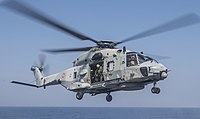
Photo from wikipedia
Background: Businesses increasingly conduct operations in remote areas where medical evacuation [Medevac(s)] carries more risk. Royal Dutch Shell developed a remote healthcare strategy whereby enhanced remote healthcare is made available… Click to show full abstract
Background: Businesses increasingly conduct operations in remote areas where medical evacuation [Medevac(s)] carries more risk. Royal Dutch Shell developed a remote healthcare strategy whereby enhanced remote healthcare is made available to the patient through use of telemedicine and telemetry. To evaluate that strategy, a review of Medevacs of Shell International employees [i.e. expatriate employees (EEs) and frequent business travellers (FBTs)] was undertaken. Method: A retrospective review of Medevac data (period 2008–12) that were similar in operational constraints and population profile was conducted. Employee records and Human Resource data were used as a denominator for the population. Analogous Medevac data from specific locations were used to compare patterns of diagnoses. Results: A total of 130 Medevacs were conducted during the study period, resulting in a Medevac rate of 4 per 1000 of population with 16 per 1000 for females and 3 per 1000 for males, respectively. The youngest and oldest age-groups required Medevacs in larger proportions. The evacuation rates were highest for countries classified as ‘high’ or ‘extreme risk’. The most frequent diagnostic categories for Medevac were: trauma, digestive, musculoskeletal, cardiac and neurological. In 9% of the total, a strong to moderate link could be made between the pre-existing medical condition and diagnosis leading to Medevac. Conclusion: This study uniquely provides a benchmark Medevac rate (4 per 1000) for EEs and FBTs and demonstrates that Medevac rates are highest from countries identified as ‘high risk’; there is an age and gender bias, and pre-existing medical conditions are of notable relevance. It confirms a change in the trend from injury to illness as a reason for Medevac in the oil and gas industry and demonstrates that diagnoses of a digestive and traumatic nature are the most frequent. A holistic approach to health (as opposed to a predominant focus on fitness to work), more attention to female travellers, and the application of modern technology and communication will reduce the need for Medevacs.
Journal Title: Journal of Travel Medicine
Year Published: 2017
Link to full text (if available)
Share on Social Media: Sign Up to like & get
recommendations!